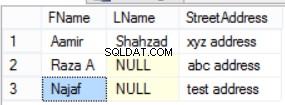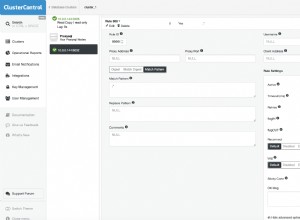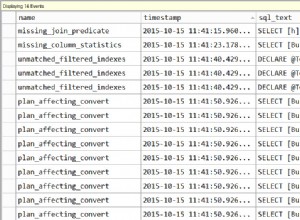Ładna zagadka :)
Możesz wygenerować tabelę, która będzie zawierała Rok i Miesiąc potrzebne na okres 12 miesięcy, a następnie wykonać na niej zewnętrzne złącze :
SET @var_year = '2013'
SET @var_month = '12'
SELECT @row := @row + (case when right(@row,2) = "12" then 89 else 1 end) as YearMonth
FROM
(select 0 union all select 1 union all select 3 union all
select 4 union all select 5 union all select 6 union all
select 6 union all select 7 union all select 8 union all
select 9 union all select 10 union all select 11) t,
(SELECT @row:=CONCAT(@var_year,right(concat('0',(@var_month-1)),2))) r
Da :
| YearMonth |
|-----------|
| 201312 |
| 201401 |
| 201402 |
| 201403 |
| 201404 |
| 201405 |
| 201406 |
| 201407 |
| 201408 |
| 201409 |
| 201410 |
| 201411 |
Spróbuj więc tego (przykład z 2014 jako rokiem i 1 jako miesiącem):
Konfiguracja schematu MySQL 5.5 :
CREATE TABLE creations(`id` int, `created_at` date )
;
INSERT INTO creations
(`id`, `created_at`)
VALUES
(1, '2013-12-11'),
(2, '2014-01-11'),
(3, '2014-01-21'),
(4, '2014-01-12'),
(5, '2014-02-22'),
(6, '2014-02-13'),
(7, '2014-03-12'),
(8, '2014-04-23'),
(9, '2014-05-23'),
(10,'2014-06-23'),
(11,'2014-08-23'),
(12,'2014-08-23'),
(13,'2014-09-23'),
(14,'2014-10-23'),
(15,'2014-11-23'),
(16,'2014-12-23')
;
**Zapytanie**:
SET @var_year = '2014'
SET @var_month = '1'
SELECT count(created_at) AS count_all,
left(YearMonth,4) as actual_year,
right(YearMonth,2) as actual_month
FROM (
SELECT @row := @row + (case when right(@row,2) = "12" then 89 else 1 end) as YearMonth FROM
(select 0 union all select 1 union all select 3 union all
select 4 union all select 5 union all select 6 union all
select 6 union all select 7 union all select 8 union all
select 9 union all select 10 union all select 11) t,
(SELECT @row:=CONCAT(@var_year,right(concat('0',(@var_month-1)),2))) r
) as YearMonthTable
LEFT OUTER JOIN creations ON
CONCAT(year(created_at),right(concat('0',month(created_at)),2)) = YearMonth
GROUP BY YearMonth
ORDER BY YearMonth ASC
Wyniki :
| count_all | actual_year | actual_month |
|-----------|-------------|--------------|
| 3 | 2014 | 01 |
| 2 | 2014 | 02 |
| 1 | 2014 | 03 |
| 1 | 2014 | 04 |
| 1 | 2014 | 05 |
| 1 | 2014 | 06 |
| 0 | 2014 | 07 |
| 2 | 2014 | 08 |
| 1 | 2014 | 09 |
| 1 | 2014 | 10 |
| 1 | 2014 | 11 |
| 1 | 2014 | 12 |
EDYTOWANO:
Możesz również utworzyć tabelę zamiast generować ją za każdym razem w podzapytaniu :
Konfiguracja schematu MySQL 5.5 :
CREATE TABLE YearMonthTable(`tblYear` int, `tblMonth` int)
;
INSERT INTO YearMonthTable
(`tblYear`,`tblMonth`)
VALUES
(2013,12),
(2014,1),
(2014,2),
(2014,3),
(2014,4),
(2014,5),
(2014,6),
(2014,7),
(2014,8),
(2014,9),
(2014,10),
(2014,11),
(2014,12),
(2015,1),
(2015,2),
(2015,3),
(2015,4),
(2015,5)
;
Zapytanie :
SET @var_year = '2014'
SET @var_month = '1'
SET @from = STR_TO_DATE(CONCAT(@var_year, '/', @var_month, '/01'), '%Y/%m/%d')
SET @to = DATE_ADD(DATE_ADD(@from, INTERVAL 12 MONTH), INTERVAL -1 DAY)
SELECT count(created_at) AS count_all,
tblYear as actual_year,
tblMonth as actual_month
FROM YearMonthTable
LEFT OUTER JOIN creations ON year(created_at) = tblYear AND
month(created_at) = tblMonth
WHERE STR_TO_DATE(CONCAT(tblYear, '/', tblMonth, '/01'), '%Y/%m/%d')
BETWEEN @from AND @to
GROUP BY tblMonth, tblYear
ORDER BY tblYear, tblMonth
Wyniki :
| count_all | tblYear | tblMonth |
|-----------|---------|----------|
| 3 | 2014 | 1 |
| 2 | 2014 | 2 |
| 1 | 2014 | 3 |
| 1 | 2014 | 4 |
| 1 | 2014 | 5 |
| 1 | 2014 | 6 |
| 0 | 2014 | 7 |
| 2 | 2014 | 8 |
| 1 | 2014 | 9 |
| 1 | 2014 | 10 |
| 1 | 2014 | 11 |
| 1 | 2014 | 12 |




